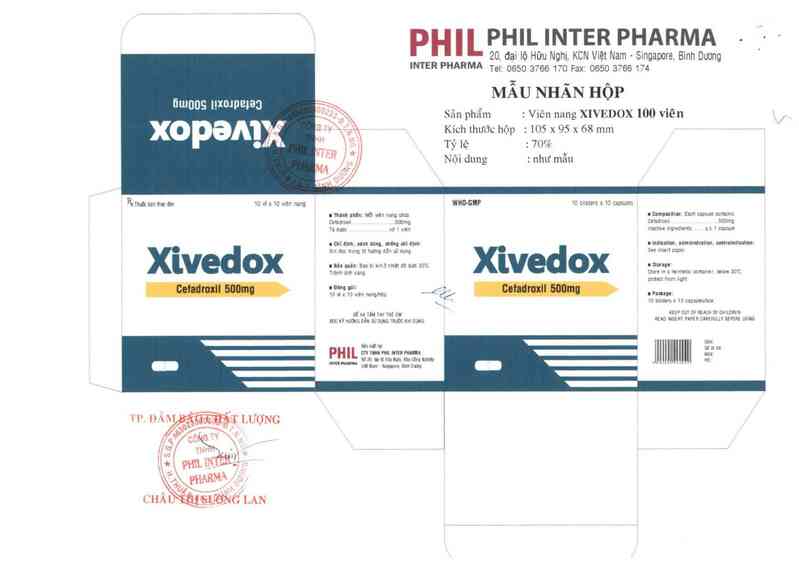
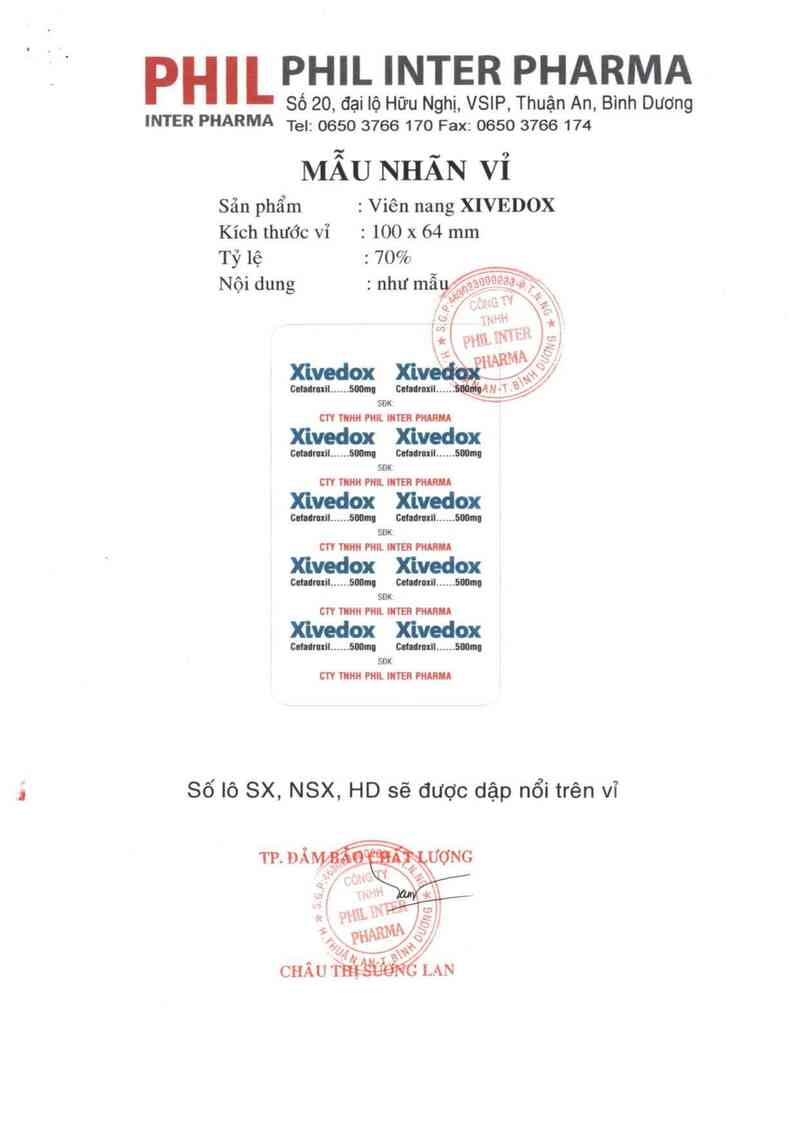
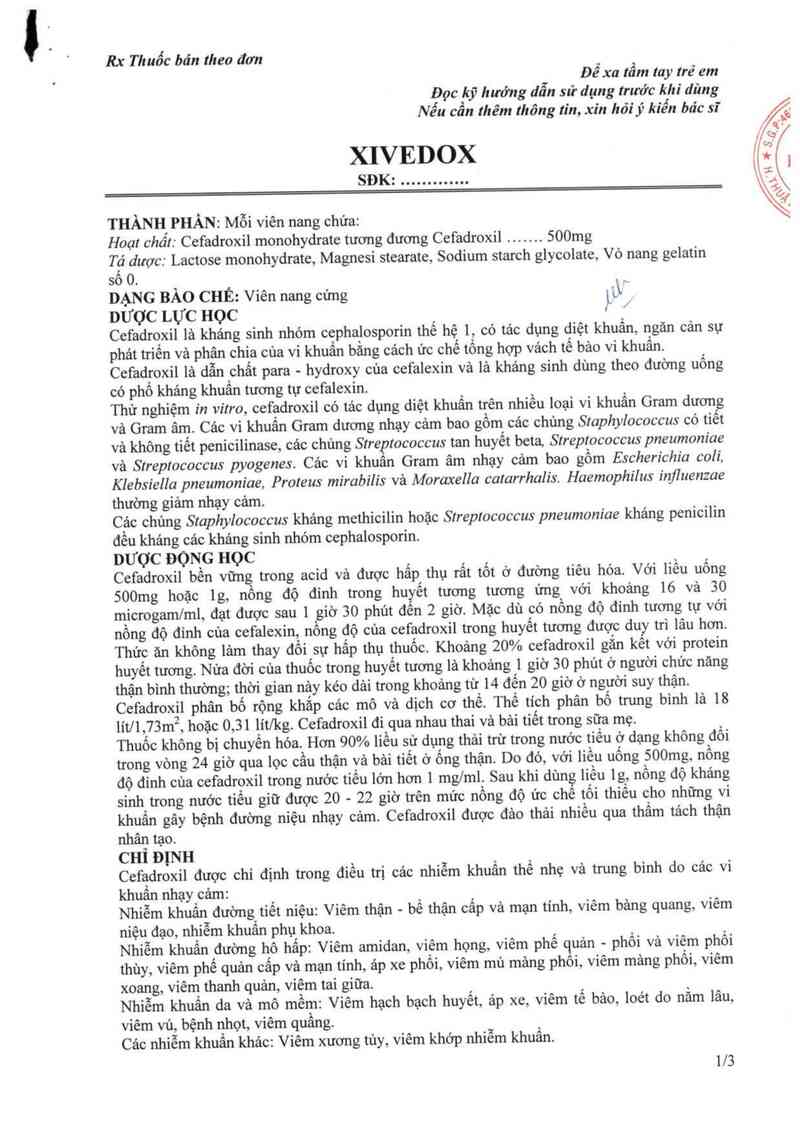
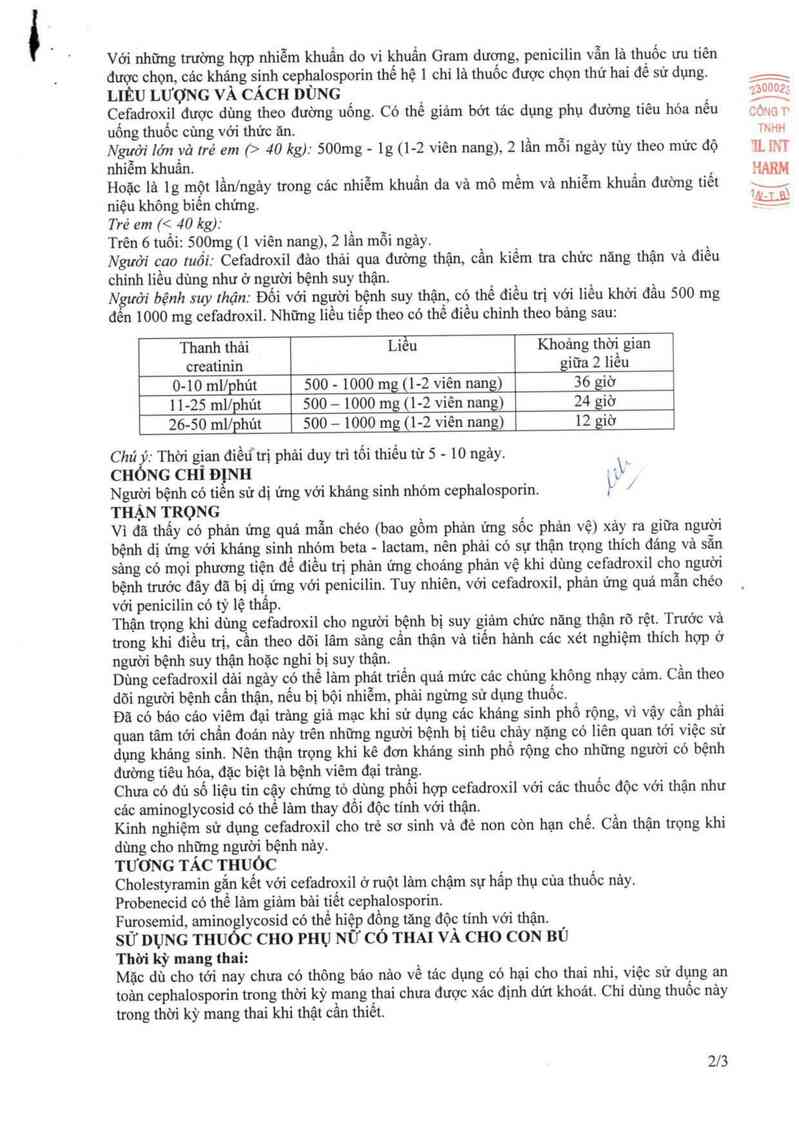
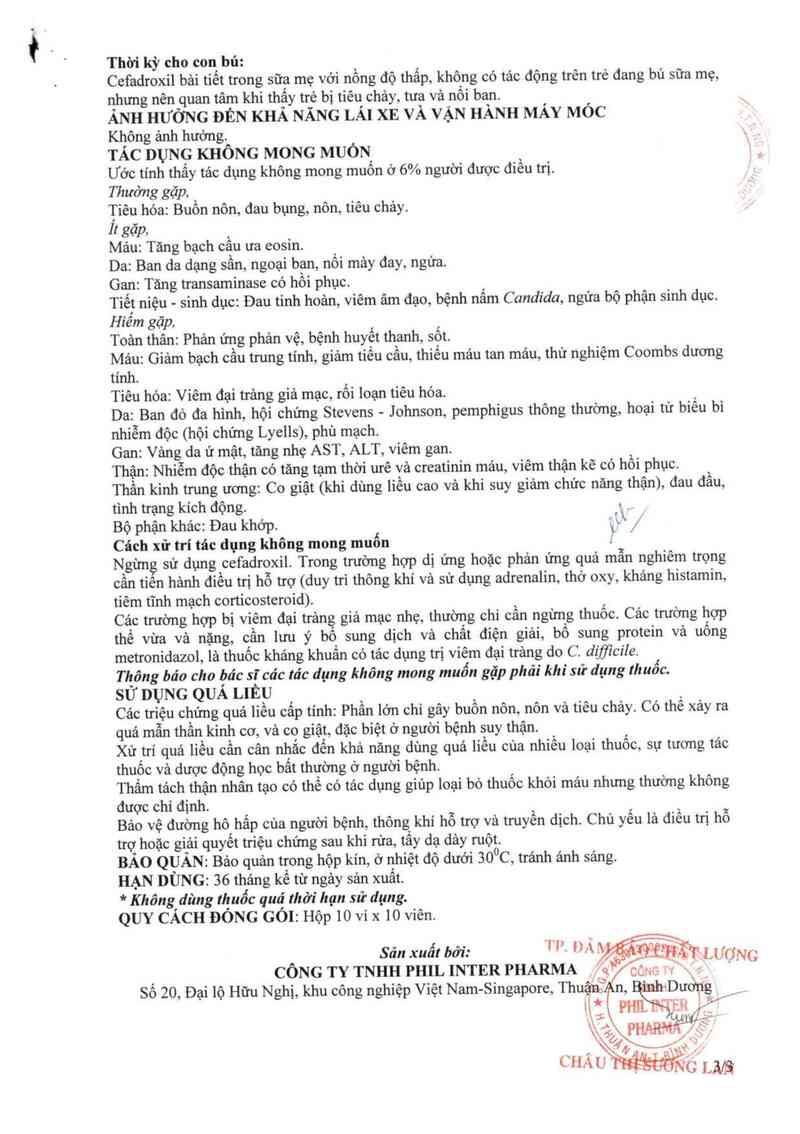
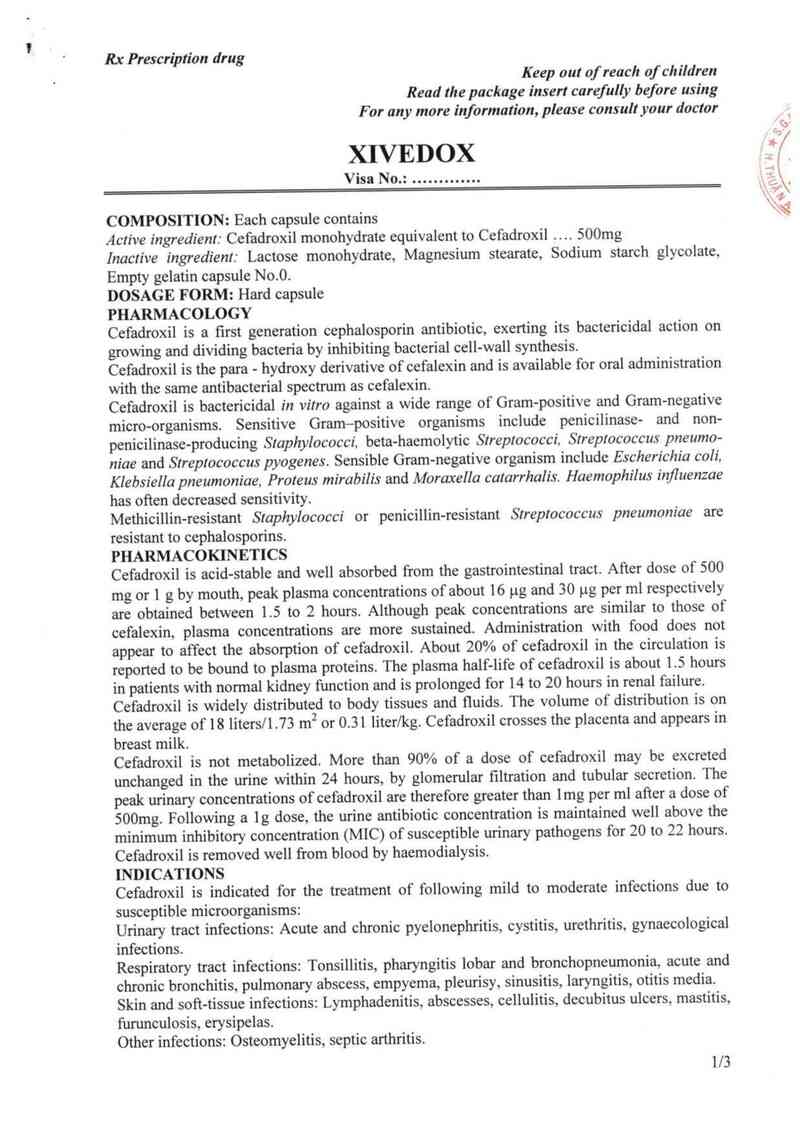
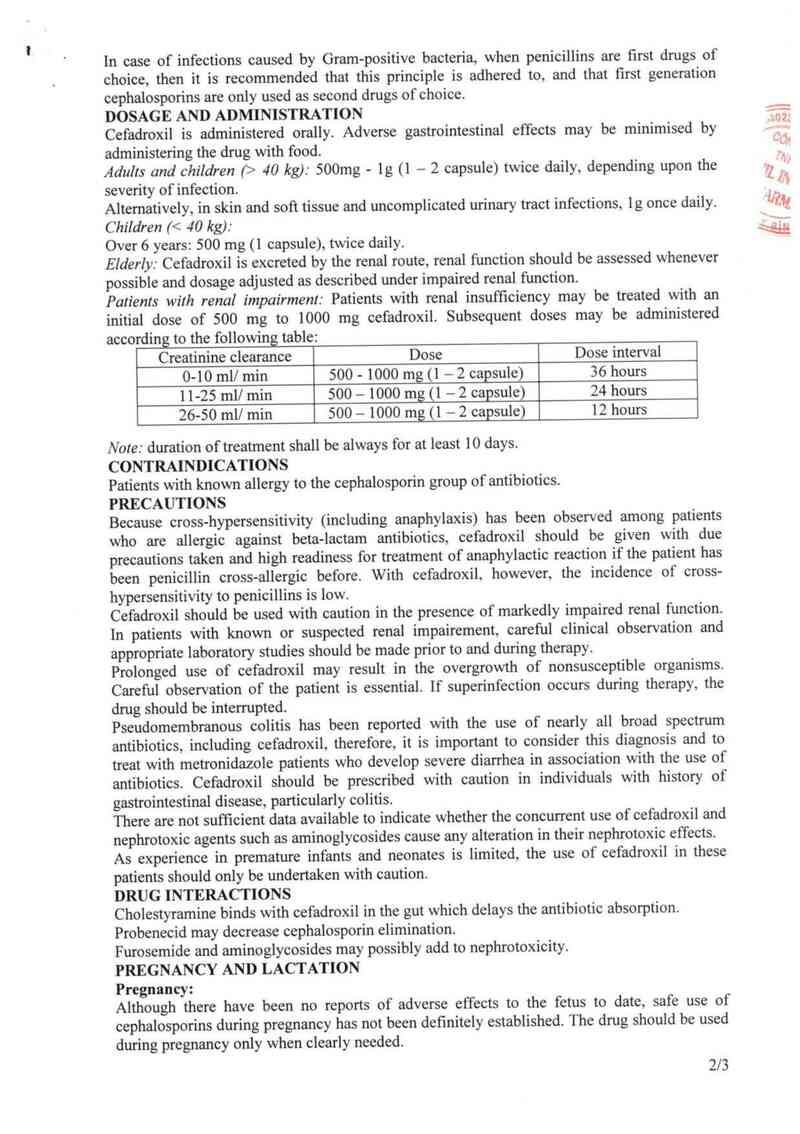
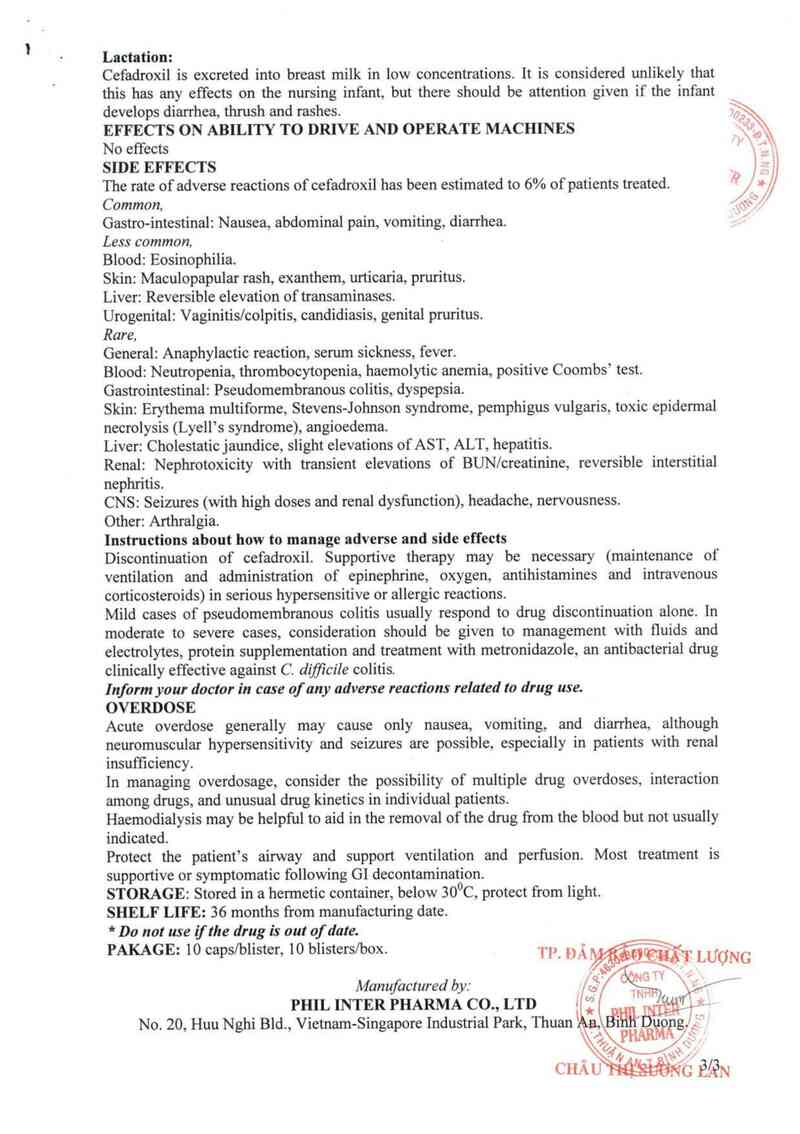
PH | L PHIL INTER PHARMA —
20. dại lộ Hữu Nghị, KCN Việt Nam - Singapore. Bình Dương
lNTER PHARMA Tel: 0650 3766 170 Fax: 0650 3766 174
MẦU NHÃN HỘP
ỦlUUOS I!XOJDBWO
., Sản phẩm : Viên nang XIVEDOX 100 viên
xơ paAìx Kích thước hộp : 105 x 95 x 68 mm _
° * Tỷ lệ : 7001
Nội dung : như mẫu
RAĨĨILẺ bán ma tbu 10 vi 11 10 v16n nang ` WHO-GMP 10 bhsiers x 10 cansules
1 I Thinh nnln: Mối viln nnnu chưa I Compullm: Euch capsute contams
Catadront 5me Cotaurmui 50qu
Ya dmc vd t Vten lnactrve inqređnenis q 6 1 causuỉe
I CM dlnh. mu mm, mơn; ohi dlnn: I lndmilun. lúmlitlslrlllon. commnơlulion:
. Xln doc tmnq to mnnq uãn '.Ủ dung See ›nsen DJpet
lv Ọx I Mo nuln: Ban bi kln.ỏ nt… 615 m aơc lve Ọx : Stouuu:
Tranh anh sang Slore … .: nermeuc mmamr. bolow JlJc
omeci irom Nghi
IBMIỊOII _~_
\ 1 m blustcrs ›: 10 cansuleslbm
Ế XA YÃM TAY TRẺ EM KEEP OƯT OF REACN Oi CHILDREN
uoc KỸ HMG oẦu SỬ DWG TRLDC KNI DUNG READ IHSERT PAPER CAREFULLY BEFORE USING
Stn ull lit
PHIL CTYỈIMMHffl UTEI mAIIA
36 70 m 0 mm Noht n… 03110 itoMu
mm ' m: 11… &num … [nua
,1111111
PH | L PHIL INTER PHARMA
Số 20, đại lộ Hữu Nghị, VSIP, Thuận An, Bình Dương
'NTER PHARMA Tel: 0650 3766 170 Fax: 0650 3766 174
2 ~ ')
MAU NHAN VI
Sân phẩm : Viên nang XIVEDOX
Kích thước vỉ : 100 x 64 mm
Tỷ lệ
Nội dung
Xìvedox
cuumil ...... sm cuumxu ...... _
son ` `~—-7"
CTY TIMN PHIL IITER PHIMA
leedox leedox
CMrutl ...... m cmmm ...... SM;
sox
CTY TNNH PMM. IITER MIA
leedox leedox
GMMII ...... % cuu…u ...... …
son
CTY TIM! PHIL IITER MIA
Xtvedox leedox
WMÌI ...... cmdmxil ...... SM]
5um'SEJK
CTY TIMM le IITEI MIA
leedox Xtvedox
Clhírlxll ...... Collitull ......
smSDK
CTY TINH PMM. IITER MIA
86 lô SX, NSX, HD sẽ được dập nổi trên vỉ
CHÂU TBẸ ỔỂLAN
Rx Thuốc bản theo đơn
Để xa tầm tay trẻ em
Đọc kỹ hướng dẫn sử dụng trưởc khi dùng
Nếu cần thêm thông tin, xin hỏi ý kiến bác sĩ
XIVEDOX
SĐK: .............
THÀNH PHÀN: Mỗi viên nang chứa:
Hoạt chất: Cefadroxil monohydrate tương đương Cefadroxil ....... 500mg
Tậ dược: Lactose monohydrate, Magnesi stearate, Sodium starch glycolate, Vỏ nang gelatin
sô 0.
DẠNG BÀO CHẾ: Viên nang cứng L'L `
DƯỢC LỰC HỌC f` /
Cefadroxil lả khảng sình nhóm cephalosporin thế hệ 1, có tác dụng diệt khuấn, ngăn cản sự
phảt triển và phân chia của vi khưẩn bằng cảch ức chế tổng hợp vách tế bảo vi khuấn.
Cefadroxil lả dẫn chất para - hydroxy cùa cefalexin và lá kháng sinh dùng theo đường uống
có phổ kháng khuấn tương tự cefalexin.
Thử nghiệm in vitro, cefadroxil có tác dụng diệt khuấn trên nhiều loại vi khuấn Gram dương
và Gram âm. Cảo vi khuẩn Gram dương nhạy cảm bao gồm các chùng Staphylococcus có tiết
và không tỉết penicilinase, cảc chủng Streptococcus tan huyết beta, Streptpcoccus pneumoniae
vả Streptococcus pyogenes. Cảc vi khuân Gram âm nhạy cảm bao gôm Escherichia coli,
Klebsiella pneumoniae, Proteus mirabilis vả Moraxella calarrhalis. Haemophilus injluenzae
thường giảm nhạy cảm.
Các chúng Staphylococcus khảng methicilin hoặc Streptococcus pneumom'ae khảng penicilin
đều kháng các khảng sỉnh nhóm cephalosporin.
DƯỢC ĐỌNG HỌC
Cefadroxil bền vững trong acid và được hấp thụ rất tốt ở đường tiêu hóa. Vởi liều uống
500mg hoặc lg, nồng độ đinh trong huyết tương tương ứng vởi khoảng 16 và 30
microgam/ml, đạt được sau 1 giờ 30 phút đến 2 giờ. Mặc dù có nồng độ đỉnh tương tự vởi
nổng độ đinh của cefalexỉn, nồng độ của cefadroxil trong huyết tương được duy trì lâu hơn.
Thức ăn không lảm thay đồi sự hấp thụ thuốc. Khoảng 20% cefadroxil gắn kêt vởi protein
huyết tương. Nửa đời cùa thuốc trong huyết tương là khoảng 1 giờ 30 phủt ở người chức năng
thận bình thường; thời gian nảy kéo dải trong khoảng từ 14 đến 20 giờ ở người suy thận.
Cefadroxil phân bố rộng khắp cảc mô vả dịch cơ thề. Thể tích phân bố trung bình là 18
lítll ,73m2, hoặc 0,31 lít/kg. Cefadroxil đi qua nhau thai và bải tiết trong sữa mẹ.
Thuốc không bị chuyển hóa. Hơn 90% liều sử dụng thải trừ trong nước tiều ở dạng không đổi
trong vòng 24 giờ qua lọc cằu thận và bải tiết ở ống thận. Do đó, với liều uống 500mg, nồng
độ đính của cefadroxỉl trong nước tiếu lớn hơn 1 mg/ml. Sau khi dùng liều lg_, nồng độ kháng
sinh trong nước tiều giữ được 20 - 22 gỉờ trên mức nồng độ ửc chê tối thiêu cho những vi
khuấn gây bệnh đường niệu nhạy cảm. Cefadroxil dược đảo thải nhiều qua thẩm tảch thận
nhân tạo.
CHỈ ĐỊNH
Cefadroxil được chỉ định trong diều trị cảc nhiễm khuẩn thề nhẹ vả trung bình do các vi
khuấn nhạy cảm:
Nhiễm khuẩn đường tiết niệu: Viêm thận - bề thận cấp và mạn tính, viêm bảng quang, viêm
niệu đạo, nhiễm khuấn phụ khoa.
Nhiễm khuẩn đường hô hấp: Viêm amidan, viêm họng, viêm phế quản - phổi và viêm phồi
thùy, viêm phế quản cấp và mạn tỉnh, ảp xe phổi, viêm mủ mảng phôi, viêm mảng phổi, viêm
xoang, viêm thanh quản, viêm tai giữa. \
Nhiễm khuẩn da và mô mềm: Viêm hạch bạch huyết, áp xe, viêm tế bảo, loét do năm lâu,
viêm vú, bệnh nhọt, viêm quầng.
Cảc nhiễm khuẩn khảo: Viêm xương tủy, viêm khớp nhiễm khuần.
1/3
Với những trường hợp nhiễm khuấn do vi khuẩn Gram dương, penicilin vẫn iả thuốc ưu tiên
được chọn, cảc khảng sinh cephalosporin thế hệ 1 chỉ là thuốc được chọn thứ hai để sử dụng.
LIÊU LƯỢNG VÀ CÁCH DÙNG
Cefadroxil được dùng theo đường uống. Có thể giảm bớt tảc dụng phụ đường tiêu hóa nếu
uống thuốc cùng với thức ăn.
Người lớn vả trẻ em (> 40 kg): 500mg - lg (1—2 viên nang), 2 lần mỗi ngảy tùy theo mức độ
nhiễm khuấn.
Hoặc là lg một lần/ngảy trong cảc nhiễm khuấn da và mô mềm và nhiễm khuẩn đường tiết
niệu không biến chứng.
Trẻ em (< 40 kg):
Trên 6 tuối: 500mg (1 viên nang), 2 lần mỗi ngảy.
Người cao tuổi: Cefadroxil đảo thải qua đường thận, cần kiếm tra chức năng thận và điều
chinh liều dùng như ở người bệnh suy thận.
N ời bệnh suy thận: Đối với người bệnh suy thận, có thể điều trị với lìều khởi đầu 500 mg
đên 1000 mg cefadroxil. Những liều tiếp theo có thể điều chình theo bảng sau:
Thanh thải Liều Khoảng thời gian
creatinin giữa 2 liều
0—10 mllphủt 500 - 1000 mg (1-2 viên nang) 36 giờ
11-25 ml/phủt 500 — 1000 mg (1-2 viên nang) 24 giờ
26-50 ml/phủt 500 — 1000 mg (1-2 viên nang) 12 giờ
Chú ỷ: Thời gian điềú'trị phải duy trì tối thiếu từ 5 - 10 ngảy.
CHỐNG CHỈ ĐỊNH ủ `
Người bệnh có tiền sử dị ứng với kháng sinh nhóm cephalosporin. } "
THẬN TRỌNG
Vì đã thấy có phản ứng quả mẫn chéo (bao gồm phản ứng sốc phản vệ) xảy ra giữa người
bệnh dị ửng với kháng sinh nhóm beta - lactam, nên phải có sự thận trọng thích đảng và sẵn
sảng có mọi phương tiện để điều trị phản ứng choáng phản vệ khi dùng cefadroxil cho người
bệnh trước đây đã bị dị ứng với penicilin. Tuy nhiên, với cefadroxil, phản ứng quả mẫn chéo
với penicilin có tỷ lệ thấp.
Thận trọng khi dùng cefadroxil cho người bệnh bị suy giảm chức năng thận rõ rệt. Trước và
trong khi điều tn'_, cần theo dõi lâm sảng cẩn thận và tiến hảnh cảc xét nghiệm thích hợp ở
người bệnh suy thận hoặc nghi bị suy thận.
Dùng cefadroxil dải ngảy có thế lảm phảt triển quá mức cảc chủng không nhạy cảm. Cần theo
dõi người bệnh cẩn thận, nếu bị bội nhiễm, phải ngừng sử dụng thuốc.
Đã có bảo cáo viêm đại trảng giả mạc khi sử dụng cảc kháng sinh phố rộng, vì vậy cần phải
quan tâm tới chẩn đoán nảy trên những người bệnh bị tiêu chảy nặng có liên quan tới việc sử
dụng kháng sinh. Nên thận trọng khi kê đơn khảng sinh phố rộng cho những người có bệnh
đường tiêu hóa, đặc biệt là bệnh viêm đại trảng.
Chưa có đủ số liệu tin cậy chứng tỏ dùng phối hợp cefadroxil với cảc thuốc độc vởi thận như
các aminoglycosid có thế lảm thay đối độc tính với thận.
Kinh nghiệm sử dụng cefadroxil cho trẻ sơ sinh và đẻ non còn hạn chế. Cần thận trọng khi
dùng cho những người bệnh nảy.
TƯONG TÁC THUỐC
Cholestyramin gắn kết với cefadroxil ở ruột lảm chậm sự hấp thụ của thuốc nảy.
Probenecid có thế lảm giảm bải tiết cephalosporin.
Furosemid, aminoglycosid có thể hiệp đồng tăng độc tính với thận.
SỬ DỤNG THUỐC CHO PHỤ NỮ có THAI VÀ CHO CON BÚ
Thời kỳ mang thai:
Mặc dù cho tới nay chưa có thông bảo nảo về tảc dụng có hại cho thai nhi, việc sử dụng an
toản cephalosporin trong thời kỳ mang thai chưa được xảc định dứt khoảt. Chỉ dùng thuốc nảy
trong thời kỳ mang thai khi thật cần thiết.
2/3
Thời kỳ cho con bủ:
Cefadroxil bải tiết trong sữa mẹ với nồng độ thấp, không có tác động trên trẻ đang bú sữa mẹ,
nhưng nên quan tâm khi thấy trẻ bị tiêu chảy, tưa vả noi ban.
ẢNH HƯỞNG ĐÊN KHẢ NĂNG LÁI XE VÀ VẶN HÀNH MÁY MÓC
Không ảnh hưởng. `
TÁC DỤNG KHÔNG MONG MUÔN `i
Ước tính thấy tác dụng không mong muốn ở 6% người được điều trị.
Thường gặp,
Tiêu hóa: Buồn nôn, đau bụng, nôn, tiêu chảy.
Ít gặp.
Máu: Tăng bạch cầu ưa eosin.
Da: Ban da dạng sần, ngoại ban, nổi mảy đay, ngứa.
Gan: Tăng transaminase có hồi phục.
Tiết niệu - sinh dục: Đau tinh hoản, viêm âm đạo, bệnh nấm Candida, ngứa bộ phận sinh dục.
Híếm gặp,
Toản thân: Phản ứng phản vệ, bệnh huyết thanh, sốt.
Mảu: Giảm bạch cầu trung tính, giảm tiểu cầu, thiếu mảu tan mảu, thử nghiệm Coombs dương
tính.
Tiêu hóa: Viêm đại trảng giả mạc, rối loạn tiêu hóa.
Da: Ban đó đa hình, hội chứng Stevens - Johnson, pemphigus thông thường, hoại từ biểu bì
nhiễm độc (hội chứng Lyells), phù mạch.
Gan: Vảng da ứ mật, tăng nhẹ AST, ALT, viêm gan.
Thận: Nhiễm độc thận có tăng tạm thời urê vả creatinin mảu, viêm thận kê có hồi phục.
Thần kinh trung ương: Co giật (khi dùng lieu cao va khi suy giảm chức nảng thận), đau đầu,
tình trạng kích động. \
Bộ phận khảc: Đau khớp. f't /
Cảch xử trí tảc dụng không mong muốn i
Ngừng sử dụng `cefadroxil. Trong trường hợp dị ứng hoặc phản ứng quả mẫn nghiêm trọng
cân tiên hảnh điêu trị hỗ trợ (duy trì thông khí và sử dụng adrenalin, thờ oxy, khảng histamin,
tiêm tĩnh mạch corticosteroid).
Cảc trường hợp bị viêm đại trảng giả mạc nhẹ, thường chỉ cần ngừng thuốc. Cảc trường hợp
thể vừa vả nặng, cần lưu ý bổ sung dịch vả chất điện giải, bổ sung protein và uống
metronidazol, lá thuốc kháng khuần có tảc dụng trị viêm đại trảng do C. difflcile.
Thông báo cho bác sĩ các tác dụng không mong muốn gặp phải khi sử dụng thuốc.
SỬ DỤNG QUÁ LIÊU
Các triệu chứng quá liều cấp tính: Phần lớn chỉ gây buồn nôn, nôn và tiêu chảy. Có thể xảy ra
quả mẫn thần kinh cơ, và co giật, đặc biệt ở người bệnh suy thận.
Xử trí quá liều cần cân nhắc đển khả năng dùng quá liều của nhiều loại thuốc, sự tương tác
thuốc và dược động học bất thường ở người bệnh.
Thấm tảch thận nhân tạo có thế có tảc dụng giúp loại bỏ thuốc khỏi mảu nhưng thường không
được chỉ định.
Bảo vệ đường hô hấp cùa người bệnh, thông khí hỗ trợ và truyền dịch. Chủ yếu lả điều trị hỗ
trợ hoặc giải quyết triệu chứng sau khi rửa, tẩy dạ dảy ruột.
BẢO QUÁN: Bảo quản trong hộp kín, ớ nhiệt độ dưới 30°C, trảnh ánh sáng.
HẠN DÙNG: 36 tháng kể từ ngảy sản xuất.
* Không dùng thuốc quá thời hạn sử dụng.
QUY CÁCH ĐÓNG GÓI: Hộp 10 vì x 10 viên.
Sãn xuất bởi: ""” "Ẩ WậỆEFÊF LƯỜNG
CÔNG TY TNHH PHIL INTER PHARMA IÝ'qfã cỘw; if" ẹJ
\
g
² P
A Ễớ-“fớiq Ỉ Ễiẩệljý
CHAU NÓ Lm
Số 20, Đại lộ Hữu Nghị, khu công nghiệp Việt Nam-Singapore, Thuận? n, Dư
iỀ me i `R
Rx Prescription drug
Keep out ofreach ofchildren
Read the package ỉnsert carefully before using
F or any more information, please consult your doctor
XIVEDOX
Visa No.: .............
COMPOSITION: Each capsule contains
Active ingredient: Cefadroxil monohydrate equivalent to Cefadroxil 500mg
Inactive ingredient: Lactose monohydrate, Magnesium stearate, Sodium starch glycolate,
Empty gelatỉn capsule No.O.
DOSAGE FORM: Hard capsule
PHARMACOLOGY
Cefadroxil is a first generation cephalosporin antibiotic, exerting its bactericidal action on
growing and dividing bacteria by inhibiting bacterial cell-wall synthesis.
Cefadroxil is the para - hydroxy derivative of cefalexin and is available for oral administration
with the same antibacterial spectrum as cefalexin.
Cefadroxil is bactericidal in vitro against a wide range of Gram-positive and Gram-negative
micro—organisms. Sensitive Gram—positive organisms include penicilinase- and non-
penicilinase-producing SIaphylococci, beta-haemolytic Streptococcỉ, Streptococcus pneumo-
niae and Streptococcus pyogenes. Sensible Gram-negative organism include Escherichia coli,
Klebsiella pneumoniae, Proteus mirabilis and Moraerla catarrhalis. Haemophilus induenzae
has often decreased sensitivìty.
Methicillin—resistant Staphylococci or penicillin-resistant Streptococcus pneumoniae are
resistant to cephalosporins.
PHARMACOKJNETICS
Cefadroxil is acid-stable and well absorbed from the gastrointestinal tract. After dose of 500
mg or 1 g by mouth, peak plasma concentrations of about 16 ụg and 30 p.g per ml respectiver
are obtained between 1.5 to 2 hours. Although peak concentrations are similar to those of
cefalexin, plasma concentrations are more sustained. Administration with food does not
appear to affect the absorption of cefadroxil. About 20% of cefadroxil in the circulation is
reported to be bound to plasma proteins. The plasma half-lìfe of cefadroxil is about 1.5 hours
in patients with normal kidney function and is prolonged for 14 to 20 hours in renal failure.
Cefadroxil is widely distributed to body tissues and fluids. The volume of distribution is on
the average of 18 litersll .73 m2 or 0.31 lỉter/kg. Cefadroxil crosses the placenta and appears in
breast milk.
Cefadroxil is not metabolized. More than 90% of a dose of cefadroxil may be excreted
unchanged in the urine within 24 hours, by glomerular filtration and tubular secretion. The
peak urinary concentrations of cefadroxil are therefore greater than 1mg per ml after a dose of
500mg. Following a lg dose, the urine antibiotic concentration is maintained well above the
mỉnimum inhibitory concentration (MIC) of susceptible urinary pathogens for 20 to 22 hours.
Cefadroxil is removed well from blood by haemodialysis.
INDICATIONS
Cefadroxil is indicated for the treatment of following mild to moderate infections due to
susceptible microorganisms:
Urinary tract infections: Acute and chronic pyelonephritis, cystitis, urethritis, gynaecological
infections.
Respiratory tract infections: Tonsillitis, pharyngitis lobar and bronchopneumonia, acute and
chronic bronchitis, pulmonary abscess, empyema, pleurisy, sinusitis, laryngitis, otitis media.
Skin and soft-tissue infections: Lymphadenitis, abscesses, cellulitis, decubitus ulcers, mastitis,
furunculosis, erysipelas.
Other infections: Osteomyelitis, septic arthritis.
1/3
, .
.6iÀ
le~ 48
'/ ưt'x'i
ẫử ;
In case of infections caused by Gram-positive bacteria, when penicillins are first drugs of
choice, then it is recommended that this principle is adhered to, and that first generation
cephalosporins are only used as second drugs of choice.
DOSAGE AND ADMINISTRATION
Cefadroxil is administered orally. Adverse gastrointestinal effects may be minimised by
administering the drug with food.
Adults and children (> 40 kg): 500mg — lg (] — 2 capsule) twice daily. depending upon the
severity of infection.
Altematively, in skin and soft tissue and uncomplicated urinary tract infections, lg once daily.
Children (< 40 kg):
Over 6 years: 500 mg (] capsule), twice daily.
Elderly: Cefadroxil is excreted by the renal route, renal function should be assessed whenever
possible and dosage adj usted as described under impaired renal function.
Patients with renaI impairment: Patients with renal ỉnsufficiency may be treated with an
initial dose of 500 mg to 1000 mg cefadroxil. Subsequent doses may be administered
according to the following table:
Creatinine clearance Dose Dose interval
0-10 m1/ min 500 - 1000 mg (1 — 2 capsule) 36 hours
11—25 ml/ min 500 — 1000 mg (l — 2 capsule) 24 hours
26-50 m1/ min 500 — 1000 mg (l — 2 capsule) 12 hours
Note: duration of treatment shall be always for at least 10 days.
CONTRAINDICATIONS
Patients with known allergy to the cephalosporin group of antibiotics.
PRECAUTIONS
Because cross-hypersensitivity (including anaphylaxis) has been observed among patients
who are allergic against beta-lactam antibiotics, cefadroxil should be given with due
precautions taken and high readiness for treatment of anaphylactic reaction if the patient has
been penicillin cross-allergỉc before. With cefadroxil, however, the incidence of cross-
hypersensitivity to penicillins is low.
Cefadroxil should be used with caution in the presence of markedly impaired renal function.
In patients with known or suspected renal impairement, careful clinical observation and
appropriate laboratory studies should be made prior to and during therapy.
Prolonged use of cefadroxil may result in the overgrowth of nonsusceptible organisms.
Careful observation of the patient is essential. If superinfection occurs during therapy, the
drug should be interrupted.
Pseudomembranous colitis has been reported with the use of nearly all broad spectrum
antibiotics, including cefadroxil, therefore, it is important to consider this diagnosis and to
treat with metronidazole patients who develop severe diarrhea in association with the use of
antibiotics. Cefadroxil should be prescribed with caution in individuals with history of
gastrointestinal disease, particularly colitis.
There are not sufficient data available to indicate whether the concurrent use of cefadroxil and
nephrotoxic agents such as aminoglycosides cause any alteration in their nephrotoxic effects.
As experience in premature infants and neonates is limited, the use of cefadroxii in these
patients should only be undertaken with caution.
DRUG INTERACTIONS
Cholestyramine binds with cefadroxil in the gut which delays the antibiotic absorption.
Probenecid may decrease cephalosporìn elimination.
Furosemide and aminoglycosides may possibly add to nephrotoxicity.
PREGNANCY AND LACTATION
Pregnancy:
Although there have been no reports of adverse effects to the fetus to date, safe use of
cephalosporins during pregnancy has not been definitely established. The drug should be used
during pregnancy only when clearly needed.
2/3
Lactation:
Cefadroxil is excreted into breast milk in low concentrations. It is considered unlikely that
this has any effects on the nursing infant, but there should be attention given if the infant
develops diarrhea, thrush and rashes. Ễị\
EFFECTS ON ABILITY TO DRIVE AND OPERATE MACHINES uÔ
No effects V \"= Ĩ\
SIDE EFFECTS t 1 -Ĩ:J`
The rate of adverse reactions of cefadroxil has been estimated to 6% of patients treated. Ộ/f' » )
Common, '1ỊxXẮỒ/"
Gastro—intestinal: Nausea, abdominal pain, vomiting, diarrhea.
Less common,
Blood: Eosinophilìa.
Skin: Maculopapular rash, exanthem, urticaria, pruritus.
Liver: Reversible elevation of transaminases.
Urogenital: Vaginitis/colpitis, candidiasis, genital pruritus.
Rare,
General: Anaphylactic reaction, serum sickness, fever.
Blood: Neutropenia, thrombocytopenia, haemolytic anemia, positive Coombs’ test.
Gastrointestinal: Pseudomembranous colitis, dyspepsia.
Skin: Erythema multiforme, Stevens-Johnson syndrome. pemphigus vulgaris, toxic epidermal
necrolysis (Lyell’s syndrome), angioedema.
Liver: Cholestatic jaundice, slight elevations of AST, ALT, hepatitis.
Renal: Nephrotoxicity with transient elevations of BUN/creatinine, reversible interstitial
nephritis.
CNS: Seizures (with high doses and renal dysfunction), headache, nervousness.
Other: Arthralgia.
Instructions about how to manage adverse and side effects
Discontinuation of cefadroxỉl. Supportive therapy may be necessary (maintenance of
ventilation and administration of epinephrine, oxygen, antihistamines and intravenous
corticosteroids) in serious hypersensitive or allergic reactions.
Mild cases of pseudomembranous colitis usually respond to drug discontinuation alone. In
moderate to severe cases, consideration should be given to management with fluids and
electrolytes, protein supplementation and treatment with metronidazole, an antibacterial drug
clinically effective against C. dỉfflcile colitis.
Injorm your doctor in case of an y adverse reactions related to drug use.
OVERDOSE
Acute overdose generally may cause only nausea, vomiting, and diarrhea, although
neuromuscular hypersensitivity and seizures are possible, especially in patients with renal
insufficiency.
In managing overdosage, consider the possibility of multiple drug overdoses. interaction
among drugs, and unusual drug kinetics in individual patients.
Haemodialysis may be helpful to aid in the removal of the drug from the blood but not usually
indicated.
Protect the patient’s airway and support ventilation and perfusion. Most treatment is
supportive or symptomatic following GI decontamination.
STORAGE: Stored in a hermetic container, below 30°C, protect from light.
SHELF LIFE: 36 months from manufacturing date.
* Do not use ịfthe drug ỉs out ofdate.
PAKAGE: 10 caps/blister, 10 blisterslbox. TP. DÃ 0
Manufactured by:
PHIL INTER PHARMA CO., LTD
No. 20, Huu Nghi Bld., Vietnam-Singapore Industrial Park, Thuan
+ "Lưu ý những sản phẩm đăng trên website thuộc loại thực phẩm chức năng: những sản phẩm này không phải là thuốc và không có tác dụng thay thế thuốc chữa bệnh"
+ Dùng thuốc theo chỉ định của Bác sĩ
+ Đọc kỹ hướng dẫn sử dụng trước khi dùng